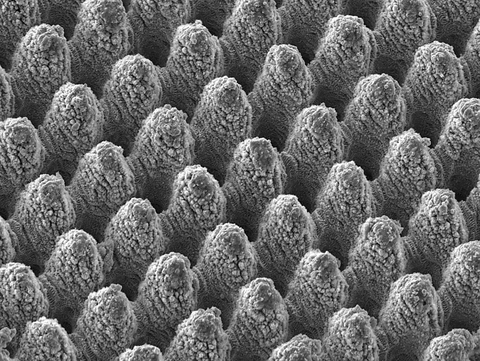Feb 04, 2019
EU-funded Horizon 2020 project for laser processing of surfaces started at TU Dresden

Laser machined metal surface for self-cleaning surfaces. The distance between the individual structural elements (distance "peak" to "peak") is 10 micrometers. In comparison, a human hair has a diameter of 50-80 micrometers.
Research project "LAMPAS" is working on the world record for the production speed of filigree engravings in order to bring laser-based processes to market maturity.
At the Technische Universität Dresden (TU Dresden) the start has given for the European flagship research project "LAMPAS" on laser-based surface functionalization. The project is being funded by the European Union (EU) with more than 5.1 million euros over the next three years as part of the Horizon 2020 program. The aim is to develop a laser-based process that can produce large filigree engravings on different surfaces in the shortest possible time. It is commonly known that laser-based functionalization of surfaces is regarded as an innovative and promising field of research for applications such as medical technology, the automotive industry or energy research.
"We are sure that the results will be groundbreaking for various industries and are therefore very pleased that we were able to win the leading European partners for the research project," says Prof. Andrés-Fabian Lasagni, coordinator of the research project and holder of the chair of large area laser based surface structuring at the TU Dresden, pleased.
Over the next three years, the research team intends to develop a laser interference-based process that can cost-effectively apply large-area micro- and nanostructures to various surfaces. The challenge is that microstructures are smaller than human hair. In order to develop the process for the broad market, the Dresden scientists are working on the world record for the production speed of such structures. The project is developing a new laser beam source that has an output power of 1.5 kilowatts and generates ultra-short laser pulses.
The researchers were inspired by nature. The self-cleaning lotus effect, also known from butterfly wings, is based on a micro- and nanostructured surface. In this sense, technologies for modifying surfaces become a real alternative to previous composite materials or for coating surfaces and offer new industrial possibilities (e.g. antibacterial surfaces, easy-cleaning surfaces, anti-fingerprint coating).
The international team around the young laser engineer of the TU Dresden, Prof. Andrés Fabian Lasagni, was among the best participants in the EU research competition "Horizon2020" in the category information and communication technologies (ICT-04-2018, Grant Nr: 825132). Over the next three years, scientists at TU Dresden will conduct research together with international partners from industry and research, including Bosch, Trumpf, Bosch-Siemens-Hausgeräte (BSH), Next Scan Technology, Near Infrared Technologies (NIT), Lasea and the European Photonics Industry Consortium (EPIC).
Media Inquiries:
Prof. Dr.-Ing. Andrés Fabián Lasagni
Faculty of Mechanical Science and Engineering
Chair of Large Area Laser Based Surface Structuring
Tel.: +49 351 463-33343
The project is an initiative of the Photonics Public Private Partnership. www.photonics21.org
(Grant Nr: 825132)
This document reflects only the author’s view and the EU is not responsible for any use that may be made of the information it contains.

